Nottinghamshire: Difference between revisions
Created page with '{{Infobox county |name=Nottinghamshire |map image=NottinghamshireBrit5.PNG |picture= |picture caption= |area=825 square miles |county town=Nottingham }} '''Nottinghamshire''…' |
mNo edit summary |
||
| (11 intermediate revisions by 2 users not shown) | |||
| Line 1: | Line 1: | ||
{{Infobox county | {{Infobox county | ||
|name=Nottinghamshire | |name=Nottinghamshire | ||
|map image= | |map image=Nottinghamshire Brit Isles Sect 5.svg | ||
|picture= | |picture=Sherwood Forest 05.jpg | ||
|picture caption= | |picture caption=Sherwood Forest | ||
|flag=County Flag of Nottinghamshire.svg | |||
|area=825 square miles | |area=825 square miles | ||
|county town=[[Nottingham]] | |county town=[[Nottingham]] | ||
}} | }} | ||
The '''County of Nottingham''' is a [[Counties of the United Kingdom|shire]] in the [[Midlands]]. Its [[county town]] is the City of [[Nottingham]]. | |||
Nottinghamshire lies between [[Derbyshire]] to the west and [[Lincolnshire]] to the east. [[Yorkshire]] lies to the north and [[Leicestershire]] to the south. | |||
{{ | ==The lie of the land== | ||
Nottinghamshire, like its neighbours [[Derbyshire]], [[Leicestershire]] and the [[West Riding of Yorkshire]], sits on extensive coal measures, up to 3,000 feet thick and occurring largely in the north of the county. These coalfields have shaped the history and development of the county. There is an oilfield near [[Eakring]]. These are lands are overlaid by sandstones and limestones in the west and clay in the east, each with its effect on the shape of faming in those parts. | |||
The ancient lands of [[Sherwood Forest]] reach from the edge of Nottingham northwards towards Yorkshire. These lands in the centre and south-west of the county have undulating hills with ancient oak woodland. The woodland itself is less extensive than in former days and much is plantation, but the remaining forest is impressive nevertheless. | |||
===Rivers=== | |||
The [[River Trent]], one of the two great rivers of the Midlands, enters the south of the county. It is fed by the [[River Soar|Soar]] and [[River Erewash|Erewash]], and then flows through Nottingham before turning north, broadening further and watering the east of Nottinghamshire as until it enters [[Lincolnshire]] at the [[Isle of Axholme]] shortly before joining the [[River Ouse, Yorkshire|Yorkshire Ouse]] to form the [[Humber]]. | |||
The [[River Idle]] is drawn from many streams running from Sherwood Forest, and like the Trent it runs through wide and flat valleys, pouring itself into the Trent at [[Misterton, Nottinghamshire|Misterton]]. | |||
===Hills=== | |||
Nottinghamshire is generally low-lying, the south of the county within the Trent valley and that of the [[River Witham]] in the very east. The [[Pennines]] edge against the west of Nottinghamshire, emptying clouds and giving the county relatively low rainfall. | |||
Strawberry Bank in [[Huthwaite]] is the highest natural point in Nottinghamshire at 666 feet.<ref>{{cite web|last=Haran|first=Brady|url=http://news.bbc.co.uk/1/hi/england/3827507.stm|title=Experiencing the highs and lows|date=25 June 2004|accessdate=18 November 2010|publisher=BBC News}}</ref>, though a higher point is Silverhill, a slag heap left by the former Silverhill colliery, which reaches 672 feet.<ref>{{cite web|url=http://www.livefortheoutdoors.com/Destinations/Search-Results/UK/England/East-Midlands/Nottinghamshire/|title=Nottinghamshire|date=|accessdate=18 November 2010|publisher=Livefortheoutdoors.com}}</ref> | |||
===The Dukeries=== | |||
[[File:Thoresby Hall 01.jpg|right|thumb|250px|Thoresby Hall]] | |||
Much of northern Nottinghamshire is the area known as "The Dukeries", so named in jest as the place where several great estates lay close together, four of them the country seats of Dukes. [[Worksop]] calls itself "the capital of the Dukeries". | |||
Remarkably, the parks of the great houses were largely contiguous. The major estates were: | |||
*Clumber House: principal seat of the Duke of Newcastle | |||
*Thoresby Hall: principal seat of the Duke of Kingston (and later of the Earl Manvers of the same family) | |||
*Welbeck Abbey: principal seat of the Duke of Portland | |||
*Worksop Manor: a seat of the Duke of Norfolk | |||
*Rufford Abbey | |||
Bestwood Lodge. a seat of the Dukes of St Albans, was also in Nottinghamshire, but over 15 miles to the south of the core Dukeries area. | |||
Northern Nottinghamshire is better known now for the coal mining villages and industrial development that came with the opening up of the Dukeries Coalfield. Nevertheless, several of the great parks remain as a feature of the green landscape. | |||
==Economy and industry== | |||
Nottingham has traditionally been a manufacturing town, now turned more to service industries. ''Boots The Chemist'' is the largest employer. From the Middle Ages Nottingham was a weaving town and here Richard Arkwright brought his new spinning machine to find success when the weavers of his native [[Lancashire]] threatened to destroy him. | |||
The north of Nottinghamshire in contrast was once turned over wholly to coal, which is clear from the landscape; slag heaps looming over many villages. A severe decline in the 1980s brought this dominance to an end, but mining remains economically significant and consequently here too are several power stations. | |||
==Caves== | |||
The sandstone of Nottingham and much of the county is peppered with caves. The Old Welsh name of the city, ''Tiguocobauc'', means "house of caves" and with justification as the hill on which Nottingham Castle is built has spacious caves beneath it and evidence of long habitation. The city has a "City of Caves" attraction showing them to the public. | |||
Into recent times, there were cave-dwellers in Nottinghamshire far outside the county town. | |||
==History== | |||
[[File:Nottinghamshire Wapentakes.svg|thumb|250px|The Wapentakes of Nottinghamshire]] | |||
Nottinghamshire lies on the Roman [[Fosse Way]], and there are Roman settlements in the county, for example at [[Mansfield]]. The county was settled by the English around the 5th century, and became part of the Kingdom of the [[Mercia]]ns, though as late as the early tenth century Asser knew the Old Welsh name for Nottingham; ''Tiguocobauc'' ("House of Caves").<ref>Asser: ''The Life of King Alfred''</ref> | |||
The county's name derives from its county town, whose name in turn is said to come from an Anglo-Saxon chieftain, Snotta, or rather his clan, the ''Snottingas''. The earliest surviving written reference to the county by name (''Snotingahamscir'') is from in 1016. | |||
In Norman times the county developed malting and woollen industries. During the industrial revolution canals and railways came to the county, and the lace and cotton industries grew. In the 19th century collieries opened and mining became an important economic sector, though these declined in the 1980s, which was the cause of the 1984-5 miners' strike. | |||
Until 1610, Nottinghamshire was divided into eight wapentakes. By 1719 just six were recognised; [[Newark Wapentake|Newark]], [[Bassetlaw]], [[Thurgarton Wapentake|Thurgarton]], [[Rushcliffe]], [[Broxtow]] and [[Bingham Wapentake|Bingham]]. Of the lost wapentakes, Oswaldbeck was absorbed into Bassetlaw and Lythe into Thurgarton. | |||
Nottinghamshire is famous for the Mediæval legend of Robin Hood, who, we are told, lived amongst the wildwood of Sherwood Forest and battled the Sheriff of Nottingham. The legend attracts many tourists who visit Sherwood Forest, the City of Nottingham and Sherwood's surrounding villages. To reinforce the Robin Hood connection, the University of Nottingham in 2010 has begun the Nottingham Caves Survey with the goal "to increase the tourist potential of these sites". The project "will use a 3D laser scanner to produce a three dimensional record of more than 450 sandstone caves around Nottingham".<ref>{{cite web|url=http://news.bbc.co.uk/local/nottingham/hi/people_and_places/history/newsid_8630000/8630926.stm |title=Laser to scan Robin Hood's prison under Nottingham city |publisher=BBC News |date=2010-04-20 |accessdate=2010-09-25}}</ref> | |||
Nottinghamshire was mapped first by Christopher Saxton in 1576, the first fully surveyed map of the county was by John Chapman who produced Chapman's Map of Nottinghamshire in 1774.<ref>Chapman's Map of Nottinghamshire 1774. Nottinghamshire County Council ISBN 0-902751-46-8.</ref> The map was the earliest printed map at a sufficiently useful scale (one statute mile to one inch) to provide basic information on village layout and the existence of landscape features such as roads, milestones, tollbars, parkland and mills. | |||
==Culture== | |||
[[File:Newstead Abbey from Morris's Seats of Noblemen and Gentlemen (1880).JPG|right|thumb|250px|Newstead Abbey (1880)]] | |||
Nottinghamshire has been the home of great poets and writers. | |||
*Lord Byron's ancestral home was Newstead Abbey, which he sold in 1818. It is now owned by Nottingham City Council and open to the public. | |||
*D H Lawrence was from [[Eastwood, Nottinghamshire]]. | |||
Nottinghamshire County Cricket Club is a first class county cricket club who play at Trent Bridge in [[West Bridgford]]. They won the County Championship in 2005. | |||
===County flag=== | |||
In 2011, [[BBC]] Nottingham was approached by two listeners calling for the county to have its own flag and Andy Whittaker of BBC Nottingham then organised a vote for such a flag. The final design was made up of elements from the designs submitted by a number of people to the radio station, and includes a St George Cross and a shield bearing a silhouette of Robin Hood. | |||
The [[Flag Institute]] registered the resultant flag as the [[county flag]] of Nottinghamshire on 20 May 2011. | |||
==Towns and villages== | |||
[[File:Nottingham-express-transit.jpg|thumb|250px|Nottingham Market Square]] | |||
===City=== | |||
*[[Nottingham]]: The county town and the county's largest town. It is an ancient city, full of history. The remains of Nottingham Castle stand on a hill in the middle of the town. | |||
===Large towns=== | |||
*[[Newark-on-Trent]] is a bridging point of the [[Fosse Way]] and [[River Trent]], growing from an Anglo-Saxon market town. Newark Castle lies in ruins along the river, slighted by Parliament after the civil war. | |||
*[[Mansfield]] in northern Nottinghamshire is the second-largest town in the county. It sits on the site of a Roman settlement, but grew after the Norman Conquest. | |||
*[[Worksop]], in the north of the county, calls itself "the capital of the Dukeries". Its origin is in an Anglo-Saxon market town but its modern form is from rapid growth in the industrial revolution with the arrival of canals and railways and the discovery of coal. Mansfield and Worksop have suffered from the decline of mining since the mines closed in the 1980s. | |||
===Other noteable towns=== | |||
*[[Arnold]] | |||
*[[Bingham]] | |||
*[[Hucknall]] | |||
*[[Kirkby-in-Ashfield]] | |||
*[[Retford]]. | |||
==Places of interest== | |||
{{UKPlacesKey|E}} | |||
*{{i-Park}} Clumber Park | |||
*[[Creswell Crags]] | |||
*{{i-Park}} Rufford Country Park | |||
*{{i-Park}} Rushcliffe Country Park | |||
*[[Southwell Minster]] | |||
*[[Sherwood Forest]] | |||
*Ye Olde Trip To Jerusalem, [[Nottingham]] (the oldest public house in the world) | |||
*[[Hawton]] Church | |||
*{{i-Castle}} [[Nottingham Castle]] | |||
*[[Welbeck Abbey]] | |||
*[[Newstead Abbey]] | |||
*Sherwood Observatory | |||
==References== | |||
{{reflist}} | |||
==Outside links== | |||
*[http://www.visitnottingham.com Visit Nottinghamshire] | |||
*[http://www.bbc.co.uk/nottingham BBC Nottingham] | |||
*[http://www.nottinghamshire.police.uk Nottinghamshire Police] | |||
*[http://www.nottinghamcavessurvey.org.uk/index.htm Nottingham Caves Survey] | |||
{{British county}} | {{British county}} | ||
Latest revision as of 18:44, 9 April 2019
| Nottinghamshire United Kingdom | |
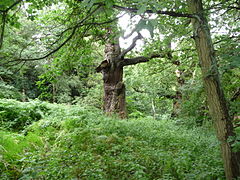 Sherwood Forest | |
|---|---|

| |
| Flag | |
| Sapienter proficiens (Progress with wisdom) | |
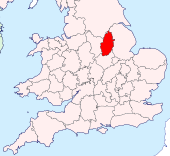
| |
| [Interactive map] | |
| Area: | 825 square miles |
| Population: | 1,096,617 |
| County town: | Nottingham |
| County flower: | Nottingham catchfly [1] |
The County of Nottingham is a shire in the Midlands. Its county town is the City of Nottingham.
Nottinghamshire lies between Derbyshire to the west and Lincolnshire to the east. Yorkshire lies to the north and Leicestershire to the south.
The lie of the land
Nottinghamshire, like its neighbours Derbyshire, Leicestershire and the West Riding of Yorkshire, sits on extensive coal measures, up to 3,000 feet thick and occurring largely in the north of the county. These coalfields have shaped the history and development of the county. There is an oilfield near Eakring. These are lands are overlaid by sandstones and limestones in the west and clay in the east, each with its effect on the shape of faming in those parts.
The ancient lands of Sherwood Forest reach from the edge of Nottingham northwards towards Yorkshire. These lands in the centre and south-west of the county have undulating hills with ancient oak woodland. The woodland itself is less extensive than in former days and much is plantation, but the remaining forest is impressive nevertheless.
Rivers
The River Trent, one of the two great rivers of the Midlands, enters the south of the county. It is fed by the Soar and Erewash, and then flows through Nottingham before turning north, broadening further and watering the east of Nottinghamshire as until it enters Lincolnshire at the Isle of Axholme shortly before joining the Yorkshire Ouse to form the Humber.
The River Idle is drawn from many streams running from Sherwood Forest, and like the Trent it runs through wide and flat valleys, pouring itself into the Trent at Misterton.
Hills
Nottinghamshire is generally low-lying, the south of the county within the Trent valley and that of the River Witham in the very east. The Pennines edge against the west of Nottinghamshire, emptying clouds and giving the county relatively low rainfall.
Strawberry Bank in Huthwaite is the highest natural point in Nottinghamshire at 666 feet.[1], though a higher point is Silverhill, a slag heap left by the former Silverhill colliery, which reaches 672 feet.[2]
The Dukeries
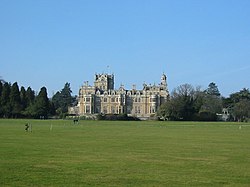
Much of northern Nottinghamshire is the area known as "The Dukeries", so named in jest as the place where several great estates lay close together, four of them the country seats of Dukes. Worksop calls itself "the capital of the Dukeries".
Remarkably, the parks of the great houses were largely contiguous. The major estates were:
- Clumber House: principal seat of the Duke of Newcastle
- Thoresby Hall: principal seat of the Duke of Kingston (and later of the Earl Manvers of the same family)
- Welbeck Abbey: principal seat of the Duke of Portland
- Worksop Manor: a seat of the Duke of Norfolk
- Rufford Abbey
Bestwood Lodge. a seat of the Dukes of St Albans, was also in Nottinghamshire, but over 15 miles to the south of the core Dukeries area.
Northern Nottinghamshire is better known now for the coal mining villages and industrial development that came with the opening up of the Dukeries Coalfield. Nevertheless, several of the great parks remain as a feature of the green landscape.
Economy and industry
Nottingham has traditionally been a manufacturing town, now turned more to service industries. Boots The Chemist is the largest employer. From the Middle Ages Nottingham was a weaving town and here Richard Arkwright brought his new spinning machine to find success when the weavers of his native Lancashire threatened to destroy him.
The north of Nottinghamshire in contrast was once turned over wholly to coal, which is clear from the landscape; slag heaps looming over many villages. A severe decline in the 1980s brought this dominance to an end, but mining remains economically significant and consequently here too are several power stations.
Caves
The sandstone of Nottingham and much of the county is peppered with caves. The Old Welsh name of the city, Tiguocobauc, means "house of caves" and with justification as the hill on which Nottingham Castle is built has spacious caves beneath it and evidence of long habitation. The city has a "City of Caves" attraction showing them to the public.
Into recent times, there were cave-dwellers in Nottinghamshire far outside the county town.
History
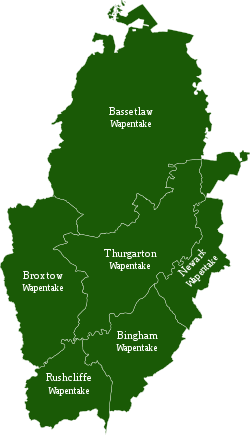
Nottinghamshire lies on the Roman Fosse Way, and there are Roman settlements in the county, for example at Mansfield. The county was settled by the English around the 5th century, and became part of the Kingdom of the Mercians, though as late as the early tenth century Asser knew the Old Welsh name for Nottingham; Tiguocobauc ("House of Caves").[3]
The county's name derives from its county town, whose name in turn is said to come from an Anglo-Saxon chieftain, Snotta, or rather his clan, the Snottingas. The earliest surviving written reference to the county by name (Snotingahamscir) is from in 1016.
In Norman times the county developed malting and woollen industries. During the industrial revolution canals and railways came to the county, and the lace and cotton industries grew. In the 19th century collieries opened and mining became an important economic sector, though these declined in the 1980s, which was the cause of the 1984-5 miners' strike.
Until 1610, Nottinghamshire was divided into eight wapentakes. By 1719 just six were recognised; Newark, Bassetlaw, Thurgarton, Rushcliffe, Broxtow and Bingham. Of the lost wapentakes, Oswaldbeck was absorbed into Bassetlaw and Lythe into Thurgarton.
Nottinghamshire is famous for the Mediæval legend of Robin Hood, who, we are told, lived amongst the wildwood of Sherwood Forest and battled the Sheriff of Nottingham. The legend attracts many tourists who visit Sherwood Forest, the City of Nottingham and Sherwood's surrounding villages. To reinforce the Robin Hood connection, the University of Nottingham in 2010 has begun the Nottingham Caves Survey with the goal "to increase the tourist potential of these sites". The project "will use a 3D laser scanner to produce a three dimensional record of more than 450 sandstone caves around Nottingham".[4]
Nottinghamshire was mapped first by Christopher Saxton in 1576, the first fully surveyed map of the county was by John Chapman who produced Chapman's Map of Nottinghamshire in 1774.[5] The map was the earliest printed map at a sufficiently useful scale (one statute mile to one inch) to provide basic information on village layout and the existence of landscape features such as roads, milestones, tollbars, parkland and mills.
Culture

Nottinghamshire has been the home of great poets and writers.
- Lord Byron's ancestral home was Newstead Abbey, which he sold in 1818. It is now owned by Nottingham City Council and open to the public.
- D H Lawrence was from Eastwood, Nottinghamshire.
Nottinghamshire County Cricket Club is a first class county cricket club who play at Trent Bridge in West Bridgford. They won the County Championship in 2005.
County flag
In 2011, BBC Nottingham was approached by two listeners calling for the county to have its own flag and Andy Whittaker of BBC Nottingham then organised a vote for such a flag. The final design was made up of elements from the designs submitted by a number of people to the radio station, and includes a St George Cross and a shield bearing a silhouette of Robin Hood.
The Flag Institute registered the resultant flag as the county flag of Nottinghamshire on 20 May 2011.
Towns and villages
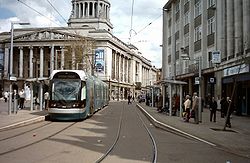
City
- Nottingham: The county town and the county's largest town. It is an ancient city, full of history. The remains of Nottingham Castle stand on a hill in the middle of the town.
Large towns
- Newark-on-Trent is a bridging point of the Fosse Way and River Trent, growing from an Anglo-Saxon market town. Newark Castle lies in ruins along the river, slighted by Parliament after the civil war.
- Mansfield in northern Nottinghamshire is the second-largest town in the county. It sits on the site of a Roman settlement, but grew after the Norman Conquest.
- Worksop, in the north of the county, calls itself "the capital of the Dukeries". Its origin is in an Anglo-Saxon market town but its modern form is from rapid growth in the industrial revolution with the arrival of canals and railways and the discovery of coal. Mansfield and Worksop have suffered from the decline of mining since the mines closed in the 1980s.
Other noteable towns
Places of interest
| Key | |
| Cathedral/Abbey/Priory | |
| Accessible open space | |
| Amusement/Theme Park | |
| Castle | |
| Country Park | |
| English Heritage | |
| Forestry Commission | |
| Heritage railway | |
| Historic House | |
| Museum (free/not free) | |
| National Trust | |
| Zoo | |
 Clumber Park
Clumber Park- Creswell Crags
 Rufford Country Park
Rufford Country Park Rushcliffe Country Park
Rushcliffe Country Park- Southwell Minster
- Sherwood Forest
- Ye Olde Trip To Jerusalem, Nottingham (the oldest public house in the world)
- Hawton Church
 Nottingham Castle
Nottingham Castle- Welbeck Abbey
- Newstead Abbey
- Sherwood Observatory
References
- ↑ Haran, Brady (25 June 2004). "Experiencing the highs and lows". BBC News. http://news.bbc.co.uk/1/hi/england/3827507.stm. Retrieved 18 November 2010.
- ↑ "Nottinghamshire". Livefortheoutdoors.com. http://www.livefortheoutdoors.com/Destinations/Search-Results/UK/England/East-Midlands/Nottinghamshire/. Retrieved 18 November 2010.
- ↑ Asser: The Life of King Alfred
- ↑ "Laser to scan Robin Hood's prison under Nottingham city". BBC News. 2010-04-20. http://news.bbc.co.uk/local/nottingham/hi/people_and_places/history/newsid_8630000/8630926.stm. Retrieved 2010-09-25.
- ↑ Chapman's Map of Nottinghamshire 1774. Nottinghamshire County Council ISBN 0-902751-46-8.
Outside links
| Counties of the United Kingdom |
|---|
|
Aberdeen • Anglesey • Angus • Antrim • Argyll • Armagh • Ayr • Banff • Bedford • Berks • Berwick • Brecknock • Buckingham • Bute • Caernarfon • Caithness • Cambridge • Cardigan • Carmarthen • Chester • Clackmannan • Cornwall • Cromarty • Cumberland • Denbigh • Derby • Devon • Dorset • Down • Dumfries • Dunbarton • Durham • East Lothian • Essex • Fermanagh • Fife • Flint • Glamorgan • Gloucester • Hants • Hereford • Hertford • Huntingdon • Inverness • Kent • Kincardine • Kinross • Kirkcudbright • Lanark • Lancaster • Leicester • Lincoln • Londonderry • Merioneth • Middlesex • Midlothian • Monmouth • Montgomery • Moray • Nairn • Norfolk • Northampton • Northumberland • Nottingham • Orkney • Oxford • Peebles • Pembroke • Perth • Radnor • Renfrew • Ross • Roxburgh • Rutland • Selkirk • Shetland • Salop • Somerset • Stafford • Stirling • Suffolk • Surrey • Sussex • Sutherland • Tyrone • Warwick • West Lothian • Westmorland • Wigtown • Wilts • Worcester • York |